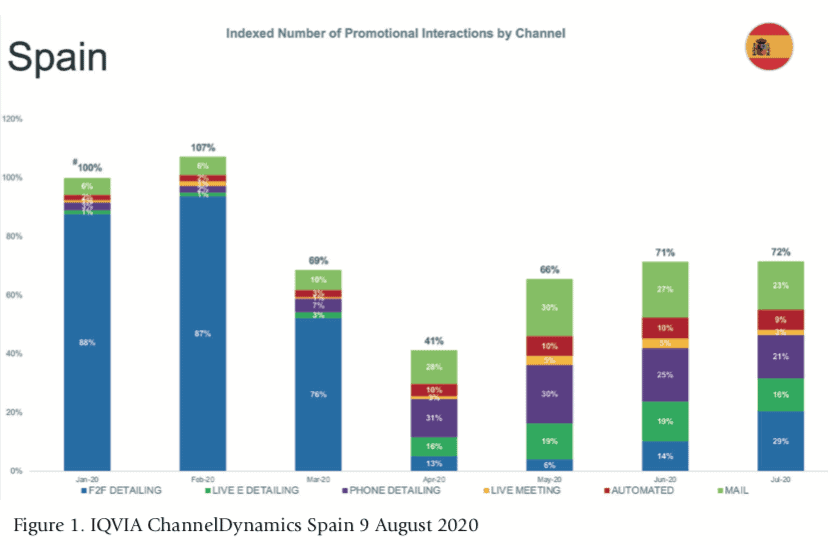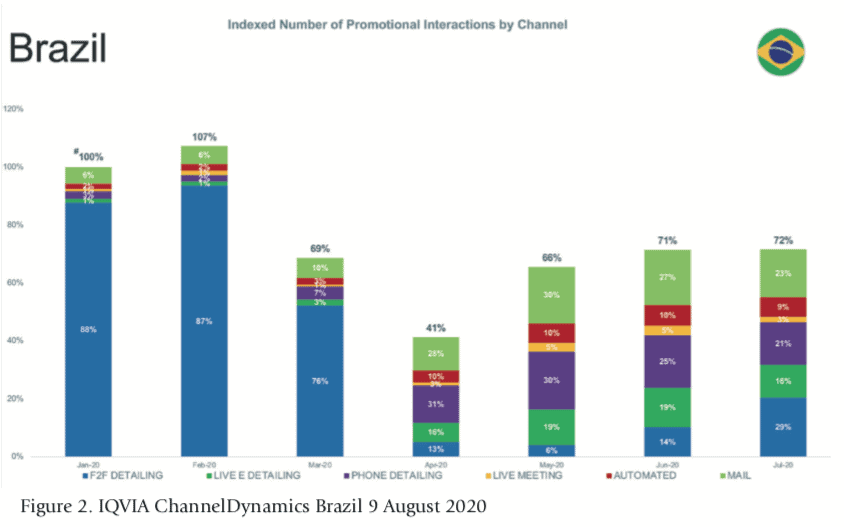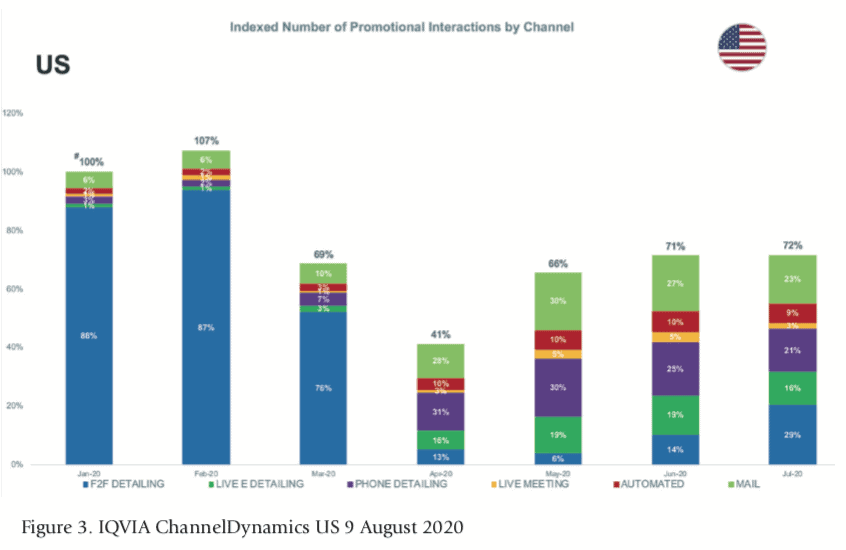
Global events in recent weeks have reminded us that different parts of the world are at different stages in their journey through the COVID-19 pandemic.
Initial lockdown measures across many countries eventually succeeded in slowing transmission rates, and loosening of these restrictions signalled a transition to the next stage of response. Now we are seeing the same countries battle further outbreaks and temporarily reimpose restrictions to try to reduce the risks of large waves of new cases.
With widespread availability of effective vaccines still some way off, many countries find themselves in a phase before the ‘new normal’, where mitigation actions continue to change and adapt as the pandemic progresses.
Like other sectors, the life sciences industry is having to continually reassess the situation in each country as it makes decisions about business operations. Commercially, with its historic reliance on in-person sales interactions with healthcare professionals (HCPs), our industry is particularly affected by the restrictions necessary to control transmission. The uncertainty associated with the current phase therefore requires agile decision-making and fluid approaches to sales activity that can adapt country by country as the situation changes.
How has promotional activity been affected to date?
Drawing on data collected by IQVIA ChannelDynamics since the start of 2020, across the largest markets for sales activity we can identify three main themes for the impact on direct promotional activity with HCPs (data covers face-to-face (F2F) detailing and meetings, postal and e-mail, phone detailing, live and automated e-detailing, live and automated e-meetings):
1. Using January as a benchmark and taking account of all promotional channels, activity volumes fell significantly between March and June. Countries that had higher levels of F2F sales activity pre-COVID-19 understandably saw the biggest reductions in total activity – Spain to 31% of January levels (Figure 1), Italy to 29%, the US to 65%.

2. The proportion of promotional activity conducted via channels other than F2F grew to fill some of the gap. In Spain, other channels went from 12% of total activity in January to 94% in May, Italy 9% to 96% and Brazil 15% to 89% (Figure 2).

3. As lockdown restrictions have eased, F2F activity levels have begun to recover but the use of other channels has remained significantly higher than at the start of 2020. In the US for example, F2F accounted for 60% of promotional activity in January, dipped as low as 6% in May and stands at 20% going into August. Over the same period, phone detailing and live e-detailing in the US has grown from less than 1% of total activity to a high of 27% and is maintaining at 22%.
Major markets insights
IQVIA has over 500 projects across the globe deploying field-based teams and first-hand experience of the variations country by country. The first two themes will come as no surprise and the pattern has been very similar across countries but with different usage rates for alternate channels. The third theme has seen most variability as lockdown restrictions and access to HCPs have continued to change country by country.
For example, IQVIA estimates suggest by the end of July US companies had mobilised around 30% of their field sales teams as restrictions eased, increasing F2F calls to 20% of promotional activity (Figure 3). In the UK, however, F2F activity has remained at about 1% of total promotional activity compared to the benchmark of 29%, despite the gradual lifting of restrictions.

Significant variability has also been seen in the uptake of live interactions via phone calls and e-detailing across countries. The US, Spain, Brazil and Italy all saw rapid activity increases in April and May from low baselines and then some drop-off as F2F activity recovered. In Spain the baseline was 4% of total promotional activity in January, rising to 49% in May and remaining at 38% in July. In Italy a peak of 41% was reached in May but this has now fallen back to 11%. In the US it grew from less than 1% to 27% and is now at 22% (Figure 3), Brazil was up to 30% but is now at 18%.
By contrast, rates in Japan have not gone above 3% in 2020, in Germany they peaked at 8% and are now down to 3% and in the UK the peak of 13% has been reached only recently.
How have HCPs responded?
ChannelDynamics data also provides an important insight into HCP preferences through a net promoter score (NPS) that we can compare across promotional channels and time from January to July. This is calculated by asking HCP contributors monthly to rate on a scale of 0-10 how likely they would be to recommend the interaction to a peer or colleague.
Interestingly, across all the countries mentioned above there has been no drop-off in the positive NPS for F2F, despite much lower activity and increased use of other channels. This positive outlook may have been an enabler for the recovery of F2F activity rates in certain countries. In Italy the positive NPS is stable at 40% and F2F visits are up from a low of 4% of promotional activity in April to 70% at the start of August. Germany also has a stable positive NPS at 35% and has seen F2F visits recover close to their January level (23% v 32% benchmark).
In countries seeing the largest increases in the use of phone and e-detailing the NPS has also risen for both channels, suggesting HCPs’ increased exposure has been a positive experience. The US has seen NPS rise by 16 percentage points for phone detailing and five for e-detailing, Spain’s increases have been seven and 13 points respectively and Italy has seen a 13-point increase for both channels. Even with their relatively lower uptake of e-detailing, both the UK and Germany have also seen increases in promoter levels. Across all the countries covered by our analysis, e-detailing has seen the biggest rise in promoters, up from 31% to 45%, with detractors falling from 31% to 16%.
Surveying IQVIA team members across the world, it is also becoming clear that a return to F2F activity is proving easier in primary care than it is in hospitals. Clear data on this
is still emerging but appears to show two main issues: access restrictions, including in some cases requirements for pre-visit COVID-19 screening, are limiting representatives’ abilities to see HCPs in hospitals and the volume of catch-up work to be done is reducing HCP time availability. There also appear to be variations in the take- up of other forms of detailing by specialty area, further adding to a complex picture.
Responding to the challenge
There is a long way to go before the world has COVID-19 in its rear-view mirror and can talk confidently about the ‘new normal’. Until then, the pharma industry has to embrace the fact that the situation by country, healthcare setting, speciality and promotional channel will continue to change as the COVID-19 journey unfolds. Like many other industries, pharma has had a crash course in adapting to new communication channels during 2020 and is on a learning journey that should inform sensible next steps in commercial planning.
Pharma and HCPs have shifted much of their personal interaction to phone and e-detailing in recent months and our data suggests it has been a relatively positive experience. This experience will continue to grow over the months ahead as the situation develops and is highly likely to have residual impact on the scale of use of these channels in promotional activity post- COVID-19.
Future success will be dependent on each company building upon this early experience, developing a clear vision for the role of these channels, creating an effective delivery infrastructure and skill base and then deploying them to the right customers at the right time.
Undoubtedly access to HCPs will continue to be challenging for some time, but evidence from countries like the US, Spain and Italy suggests they continue to see value in F2F interactions with pharma as long as it remains additive and not disruptive to their ability to deliver care. The success of these interactions has always been driven by the quality of the representative and the relationships built over time. Maintaining these relationships while the pandemic persists requires companies and their representatives to adopt a flexible approach that embraces a mix of phone, digital and in-person interactions, properly co-ordinated and tailored to HCP circumstances and preferences.
If you would like to know more about our work on COVID-19, please visit IQVIA’s COVID-19 Resource Center at www.Iqvia.com
You can also read our previous article
The power of remote personal interactions: COVID-19 pandemic and the increasing role of remote engagement on the PMLiVE website.
Note: data cited in this article is drawn from IQVIA’s proprietary data assets accessed in August 2020.
John Procter is VP Offering Development Contract Sales & Medical Solutions Global Business Unit at IQVIA




